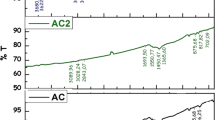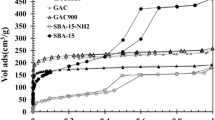Abstract
Adsorption of acetone on active carbon and active carbon supported metals (Ni, Cu, Zn and Cd) have been studied as a function of temperature. Thermodynamic parameters such as ΔG 0, ΔH 0, and ΔS 0 are calculated from virial and Langmuir isotherm expressions. It is observed that active carbon supported metals have more adsorption affinity for acetone as compared to active carbon. Results show that the increase in adsorption affinity for active carbon supported metals is not due to configurational factors affecting the entropy of adsorption, but because of enhanced enthalpy of adsorption. XRD spectra show that active carbon supported metals adsorbents are amorphous and metal residues are present on the surface of active carbon in its reduced form. From adsorption data, isosteric heats and molar entropies of adsorption were calculated as a function of coverages and temperature. The values of isosteric heats of adsorption were found to be higher for active carbon supported metals, which may be due to the chemisorption of adsorbate molecules with metal sites present on the surface of active carbon. The extent of coordination of adsorbate molecules with metal sites is discussed on the basis of the acidic character of metal.
Similar content being viewed by others
References
Suda Y, Morimoto T, Nagao M (1987) Langmuir 3:99
Ruthven DM, Raghavan NS, Hassan MM (1986) Chem Eng Sci 41:1325
Koresh JE, Sofer A (1983) Sep Sci Technol 18:723
Hassan MM, Raghavan NS, Ruthven DM (1987) Chem Eng Sci 42:2037
Grunewald GC, Drago RS (1990) J Mol Catal 58:227
Song G, Jiang Z (1987), Sepu 5:58
Surinova SI, Kostomarova MA, Petokhov SS (1987) Zh Prikl Khim (Leningrad) 60:640
Gerald GC, Russel SD (1991) J Am Chem Soc 113:1639
Arai H, Uehara K, Kinoshita S, Kunug T (1972) Ind Eng Chem Prod Res Develop 11:308
Cilense M, Banedetti AV, Jafelicci JM, Varela JA, Varela JA, DaCosta RA (1984) Electrca Quim 9:23
Berg R, Gulfrandsen AH, Neefjes GA (1977) Rev Port Quim 19 (1–4):378
Hammerstorm JL, Sacco A (1986) J Catal 110(2):293
Hirai H, Wada K, Komiyama M (1986) Bull Chem Soc Jpn 59:1043
Dollimore D, Heal GR (1964) J Appl Chem (London) 14:109
Anderson MW, Klinowski J (1986) J Chem Soc Faraday Trans I 82:3569
Barrer RM, Gibbons RM (1963) Trans Faraday Soc 59:2875
Barrer RM, Davis JA (1980) Proc R Soc London Ser A 320:289
Bezus AG, Kiselev AV, Sedlacek Z, Pham Quang Du (1971) Trans Faraday Soc 67:468
Barrer RM, Davis JA (1971) Proc Roy Soc Ser A 322:1
Bye GC, McEnvoy M, Malati MA (1982) J Chem Biotechnol 32:781
Mustafa S, Hussain SY, Rehana N, Alamzeb (1989) Solven Extract Ion Exch 7(4):705
Jaroneic M, Patrykiejew A, Borowko M (1979) Z Phys Chem 260(2):221
Harai H, Wada K, Komiyama M (1986) Bull Chem Soc Jpn 59:2217
Siedlewski J, Rychliki G (1975) Prezern Chem 54(6):334
Davies JA, Hartley FR (1981) Chem Rev 81:79
Denuth JE, Ibach H (1979) Chem Phys Letters 60:395
Johnson S, Madix RJ (1981) Surface Sci 103:361
Bare SR, Stroscio JA (1985) Surface Sci 150:399
Wach IH, Madix RJ (1978) J Catalysis 53:208
Sexton BA (1979) Surface Sci 88:299
Wach IH, Madix RJ (1978) Surface Sci 76:531
Kojima I, Sugihera H, Miyazak, Yasumoi I (1981) J Chem Soc Faraday Trans I 77:1315
Avery Neil A (1983) Surface Sci 125:771
Sexton BA, Hughes AE (1984) Surface Sci 140:227
Afzal M, Jaffar M, Yasmin S (1977) Colloid Polym Sci 255:252
Afzal M (1971) Kolloid ZUR Polymere 248:1026
Afzal M, Ahmed J (1975) Colloid Polym Sci 253:635
Author information
Authors and Affiliations
Rights and permissions
About this article
Cite this article
Afzal, M., Mahmood, F. & Saleem, M. Thermodynamics of adsorption of acetone on active carbon supported metal adsorbents. Colloid Polym Sci 270, 917–926 (1992). https://doi.org/10.1007/BF00657737
Received:
Accepted:
Issue Date:
DOI: https://doi.org/10.1007/BF00657737




